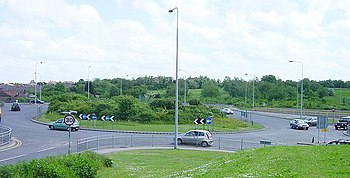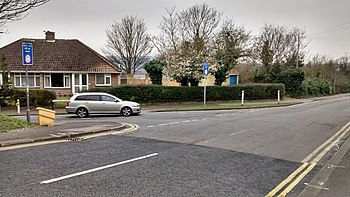Junctions (software)
Junctions is a software package by Transport Research Laboratory. It incorporates ARCADY and PICADY which were previously separate programs marketed by TRL.
ARCADY
| Developer(s) | Transport Research Laboratory |
|---|---|
| Stable release | 9.5.0
/ May 2018 |
| Operating system | Windows |
| Type | Traffic software |
| License | Proprietary software |
| Website | http://www.trlsoftware.co.uk/ARCADY |

ARCADY is the acronym for (Assessment of Roundabout Capacity And DelaY). This software, produced by the Transport Research Laboratory (UK), models traffic capacity, queues and delays at roundabouts.[1] The software is largely based on empirical relationships between roundabout geometry and capacity, which were established as the result of extensive research carried out on existing roundabouts on the UK road network, as well as controlled test track facilities over a period of over a decade.[2]
The program is used by traffic engineers when assessing existing layouts or when analysing the impacts of proposed design changes. Estimates of annual accident frequencies can also be obtained.[3]
The capacity and safety relationships which ARCADY utilises are discussed in the UK's Design Manual for Roads and Bridges.[4]
RODEL is similar to ARCADY and utilises TRL equations under licence from TRL.
Recent developments
From ARCADY 7 onwards, the software has been capable of communicating with certain CAD software, aiding real-time design analysis.
ARCADY 7 introduced the ability to model simple networks of linked roundabouts.
In ARCADY 8, the Highway Capacity Manual 2010 methodology for roundabout analysis was made available.
ARCADY 8 also introduced a simulation technique to deal with the modelling of certain configurations such as lane usage at roundabouts.
'ARCADY Lite' is a simplified version of ARCADY 8 that provides basic analysis of roundabouts.
ARCADY 9 includes built-in tools for graphically measuring roundabout geometries and for assisting with the transfer of traffic flow data from other sources (typically spreadsheets).
PICADY

PICADY (Priority Intersection Capacity and Delay) is a program for modelling three and four arm priority junctions in a similar manner to ARCADY. It is based on empirical relationships which link capacity and safety with road geometric parameters such as carriageway widths and visibilities.[5] These relationships are discussed in the UK Design Manual for Roads and Bridges.[6]
PICADY can also model pedestrian crossings on the approaches to priority junctions.[7]
PICADY 9 includes Highway Capacity Manual 2010 models for Two-Way Stop-Controlled and All-Way Stop-Controlled intersections.
References
- Kimber, R.M., The Traffic Capacity of Roundabouts, TRL Laboratory Report LR942, 1980.
- Roundabout Design for Capacity and Safety: the UK Empirical Methodology
- Maycock, G. and R.D. Hall, Accidents at 4-Arm Roundabouts, TRL Laboratory Report LR1120, 1984.
- DMRB TD 16/07: Geometric Design of Roundabouts
- Kimber, R.M. and R.D. Coombe, The Traffic Capacity of Major/Minor Priority Junctions, TRL Laboratory Report SR582, 1980.
- DMRB TD 42/95: Geometric Design of Major/Minor Priority Junctions
- Transport for London, Traffic Modelling Guidelines v3.0, http://content.tfl.gov.uk/traffic-modelling-guidelines.pdf